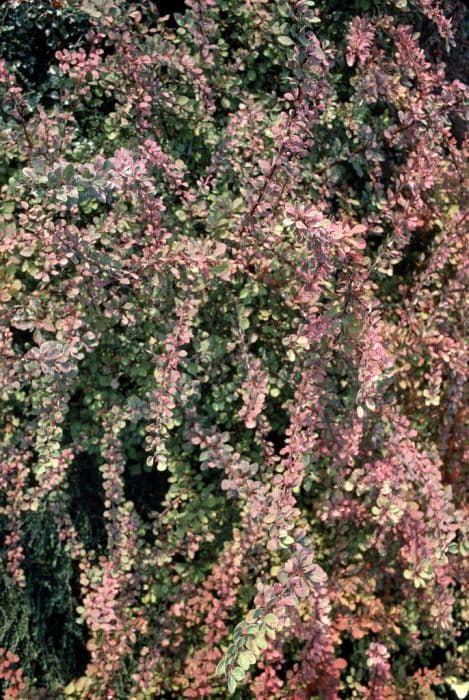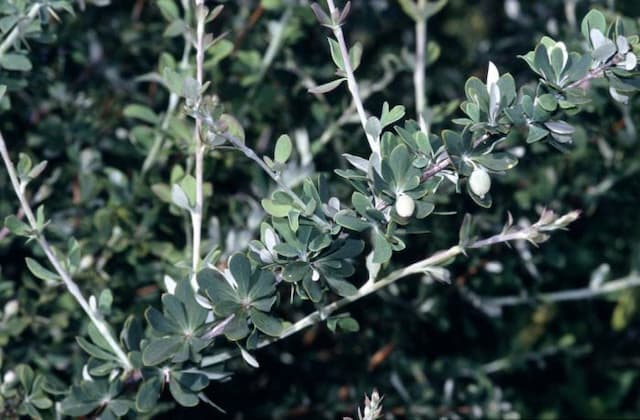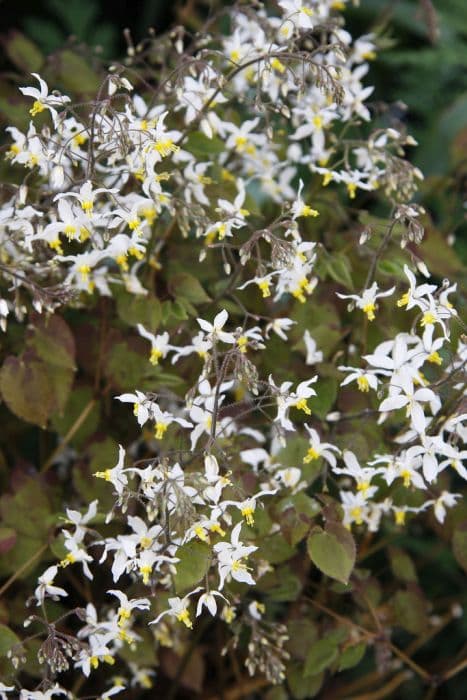Oregon grape Mahonia aquifolium

ABOUT
The common name of Mahonia aquifolium is Oregon grape. This plant is easily recognizable by its bold and textured visual traits. It has pinnate leaves that are thick and leathery, resembling those of holly with their spiny edges. Its leaves are typically glossy, showing a rich green hue that can turn into purplish-bronze during the colder months. Oregon grape produces clusters of bright yellow flowers that are small but numerous, forming tight bunches that give off a subtle fragrance. Following the flowering period, the plant develops small, round berries that are dark blue to blackish in color, often with a powdery-gray bloom on the surface, which resembles that of grapes – hence the name. The appearance of these berries is one of the reasons why the plant is admired as an ornamental. Furthermore, Oregon grape can be recognized by its knobby, multi-stemmed appearance, with the stems covered in grayish to brownish bark. The overall impression of the plant is one of hardiness and resilience, often thriving in a variety of conditions, presenting a sharp yet inviting aspect. Its evergreen nature ensures that it remains a point of interest in the landscape throughout the year.
About this plant
 Names
NamesFamily
Berberidaceae.
Synonyms
Oregon Grape, Holly-Leaved Berberis, Oregon Grape Holly, Mountain Grape.
Common names
Berberis aquifolium, Mahonia diversifolia, Mahonia piperiana, Berberis diversifolia, Berberis piperiana, Odostemon aquifolium.
 Toxicity
ToxicityTo humans
Oregon grape is generally considered non-toxic to humans, and its ripe berries are edible when cooked. However, consuming large quantities of the berries may lead to gastrointestinal discomfort, such as nausea, vomiting, and diarrhea due to the presence of certain alkaloids. The roots and wood contain higher concentrations of these compounds and should be avoided. There is no known significant toxicity from casual handling of the plant, but ingestion of non-fruit parts, especially in large amounts, is inadvisable and might lead to more severe symptoms.
To pets
Oregon grape, when it comes to pets, can cause mild to moderate gastrointestinal upset if ingested in significant amounts. Symptoms of poisoning in pets can include vomiting, diarrhea, lethargy, and in rare cases weakness. The most toxic parts are the roots and wood, but generally, pets are not likely to consume large enough quantities of the plant to cause severe toxicity. Nonetheless, it's prudent to keep an eye on pets when they are around the plant and to discourage them from chewing on any part of it.
 Characteristics
CharacteristicsLife cycle
Perennials
Foliage type
Evergreen
Color of leaves
Green
Flower color
Yellow
Height
3-6 feet (0.9-1.8 meters)
Spread
2-5 feet (0.6-1.5 meters)
Plant type
Shrub
Hardiness zones
5-9
Native area
North America
Benefits
 General Benefits
General Benefits- Ornamental value: Mahonia aquifolium, commonly known as Oregon grape, is often used in gardens and landscapes for its attractive holly-like evergreen foliage and its clusters of yellow flowers that bloom in early spring.
- Wildlife support: It provides nectar for pollinators like bees during its flowering season, and the blue-black berries that follow are a food source for birds and small mammals.
- Drought tolerance: Once established, Oregon grape has good drought tolerance, making it suitable for xeriscaping or low-water-use gardens.
- Shade tolerance: This shrub is capable of thriving in shady conditions where other plants may struggle, making it versatile for different garden situations.
- Erosion control: With its strong root system, Oregon grape can help stabilize soil and prevent erosion on slopes or in areas with loose soil.
- Low maintenance: Oregon grape requires minimal care once established, needing little pruning or additional watering, which is suitable for low-maintenance landscaping.
 Medical Properties
Medical Properties- Antimicrobial: Oregon grape has been used for its potential ability to fight bacterial and fungal infections.
- Anti-inflammatory: It may help reduce inflammation and soothe skin conditions such as eczema and psoriasis.
- Choleretic: It is believed to stimulate bile production and aid in digestion.
- Antioxidant: The plant contains compounds that may protect cells from oxidative damage.
- Immunomodulatory: Some evidence suggests Oregon grape may influence immune system responses.
- Liver protective: It may have hepatoprotective effects that help improve liver function.
- Antidiabetic: There is some potential for Oregon grape to help regulate blood sugar levels.
 Air-purifying Qualities
Air-purifying QualitiesThis plant is not specifically known for air purifying qualities.
 Other Uses
Other Uses- Mahonia aquifolium, commonly known as Oregon grape, can be used as a natural dye, with the bark giving a yellow color and the berries producing a purple dye.
- The wood of Oregon grape is extremely dense and can be used for making small woodworking objects such as tool handles or inlay work.
- The leaves of Oregon grape can be used in floral arrangements, particularly in the winter, due to their holly-like appearance and long-lasting nature.
- The berries can be made into jams, jellies, or wine, offering a tart flavor that can be similar to that of grapes, though more bitter.
- Used in permaculture design, Oregon grape can function as a protective barrier for more delicate plants due to its spiny leaves.
- In landscaping, the plant is valued for erosion control on slopes due to its dense root system that holds soil in place.
- Oregon grape can serve as a natural source of food for wildlife, with birds and mammals consuming the berries.
- The bright yellow flowers attract pollinators, thus acting as a beneficial plant for bees, especially early in the season when other food sources are scarce.
- The plant can be used in crafting, with the berries being integrated into traditional beadwork as natural beads once dried.
- Due to its hardiness and low maintenance, Oregon grape is planted as a privacy hedge in urban and suburban gardens.
Interesting Facts
 Feng Shui
Feng ShuiThe Oregon grape is not used in Feng Shui practice.
 Zodiac Sign Compitability
Zodiac Sign CompitabilityThe Oregon grape is not used in astrology practice.
 Plant Symbolism
Plant Symbolism- Strength and Resilience - Mahonia aquifolium, commonly known as Oregon Grape, has a tough and spiky exterior, much like holly. This characteristic symbolizes inner strength and the ability to withstand challenging conditions.
- Healing - The Oregon Grape is known for its medicinal properties, and thus, it is often associated with healing. Its roots are used to make herbal remedies that help treat a variety of ailments.
- Prosperity - The bright yellow flowers of the Oregon Grape are suggestive of gold, which can be symbolic of wealth and prosperity.
- Adaptation - As a plant that can thrive in various soil conditions and environments, the Oregon Grape symbolizes adaptability and the ability to thrive in diverse situations.
- Protection - With its holly-like leaves, Oregon Grape is sometimes considered a symbol of protection, offering shelter and safety to birds and small animals with its dense, spiny foliage.
 Water
WaterOregon Grape should be watered regularly but moderately, ensuring the soil is moist but not soggy. During the growing season, spring and summer, this typically means watering approximately once a week with about 1 to 1.5 gallons depending on the size of the plant and the weather conditions. In the fall and winter, watering frequency should be reduced to every other week or less, as the plant requires less moisture during dormancy. Overwatering can lead to root rot, so it’s important to check the soil moisture level before adding more water. Allow the top inch of soil to dry out between waterings to promote healthy roots.
 Light
LightOregon Grape thrives in conditions where it can receive full to partial shade. It does best in a spot that is shielded from the harsh afternoon sun but can benefit from the gentle morning light. An ideal location would be under the canopy of larger trees or on the northern or eastern side of a building where it can get filtered sunlight without being exposed to intense direct rays for prolonged periods.
 Temperature
TemperatureOregon Grape is a hardy plant that can withstand a range of temperatures. It can survive minimum temperatures down to around -20°F and maximum temperatures as high as 90°F, although it prefers a cooler climate. The ideal temperature range for Oregon Grape is between 60°F and 75°F. Extreme temperatures outside of this range, especially heat, can stress the plant.
 Pruning
PruningOregon Grape benefits from pruning to maintain its shape, remove any dead or diseased wood, and encourage new, healthy growth. The best time to prune is in late winter or early spring before new growth begins. Pruning should be done sparingly, focusing on thinning out crowded areas and cutting back by only about one-third of the length of overgrown branches.
 Cleaning
CleaningAs needed
 Soil
SoilOregon Grape thrives in a well-draining soil mix with a pH between 5.5 and 7.0. A mixture of loamy soil, peat, and sand or perlite encourages good drainage and aeration. Enriching the soil with organic compost can provide additional nutrients desirable for this plant's growth.
 Repotting
RepottingOregon Grape doesn't require frequent repotting; it can be done every 2 to 3 years. Ensure that you choose a pot only slightly larger than the previous one to prevent water from stagnating in excess soil, which can lead to root rot.
 Humidity & Misting
Humidity & MistingOregon Grape prefers moderate humidity levels but is quite adaptable and can tolerate the drier air found in most home environments without the need for extra humidity.
 Suitable locations
Suitable locationsIndoor
Place Oregon Grape in bright, indirect light and ensure soil is well-draining.
Outdoor
Plant Oregon Grape in partial to full shade; it tolerates a range of soils.
Hardiness zone
5-9 USDA
 Life cycle
Life cycleOregon grape (Mahonia aquifolium) begins its life cycle when the seeds germinate, typically in the spring following stratification to break dormancy. The seedlings develop into juvenile plants with pinnately compound leaves that form rosettes. As they mature, Oregon grape plants develop woody stems and reach flowering maturity, which involves producing clusters of small yellow flowers that are pollinated by insects. Following pollination, the flowers develop into blue-purple berries that contain seeds, which are dispersed by birds and other animals. The plant also reproduces vegetatively through its extensive rhizome system, allowing it to create colonies. Over time, Oregon grape plants can become quite large and may live for many years, with some reaching up to 6 feet in height.
 Propogation
PropogationPropogation time
Spring to Autumn
The Oregon grape (Mahonia aquifolium) is most commonly propagated by seed or cuttings. The preferred method is to take semi-ripe cuttings during late summer. These are stem cuttings taken from the current year's growth that has begun to harden but is not completely woody. Cut a 4 to 6 inch (approximately 10 to 15 centimeters) length of stem, strip the lower leaves, and dip the cut end in rooting hormone powder. The cutting should then be placed in a well-draining potting mix, kept moist, and covered with a plastic bag to maintain humidity. Cuttings usually root within several weeks to a few months. Once the cuttings have established a strong root system, they can be transplanted to a more permanent location.









